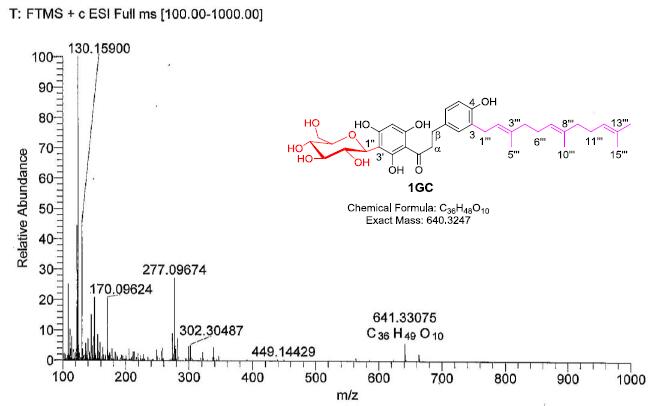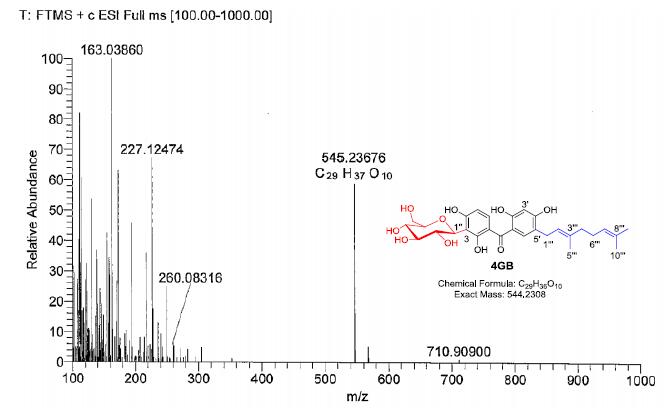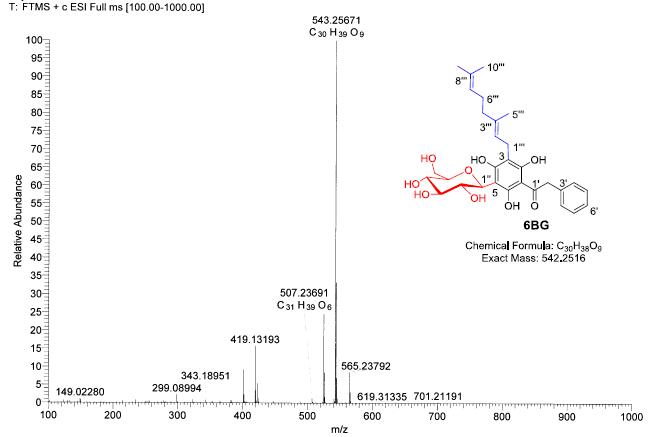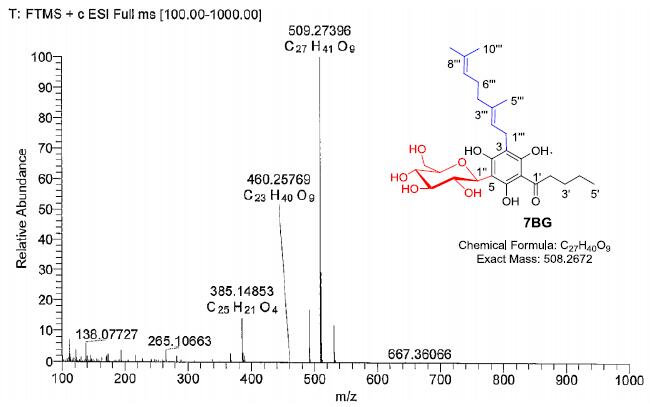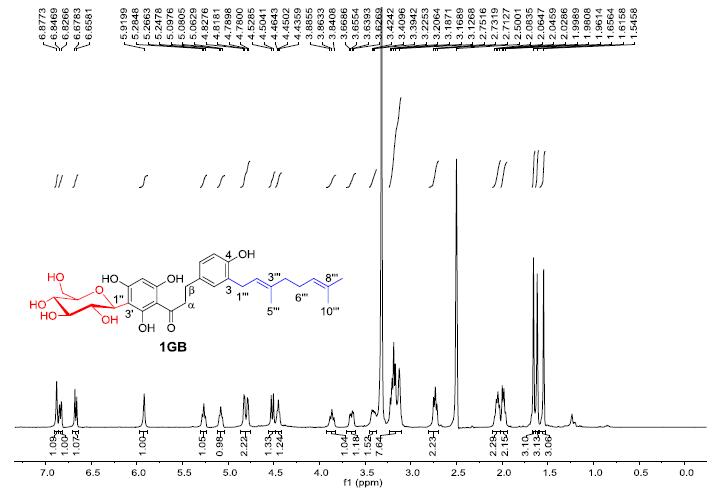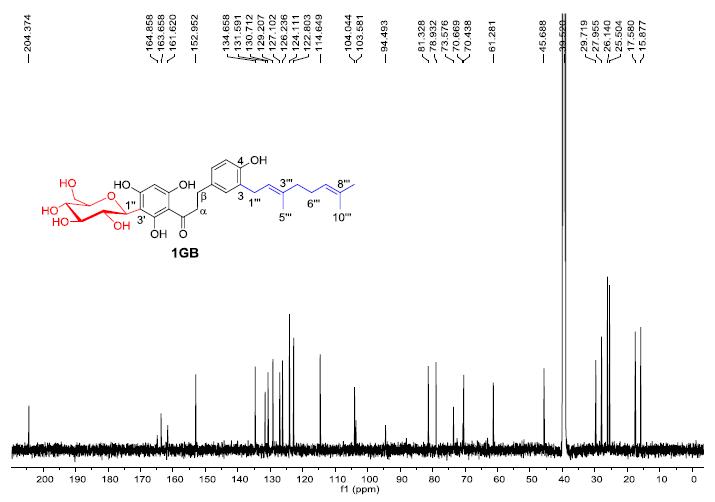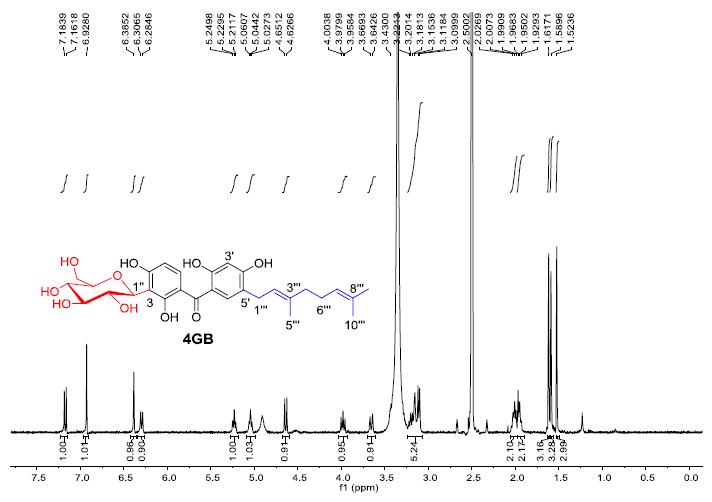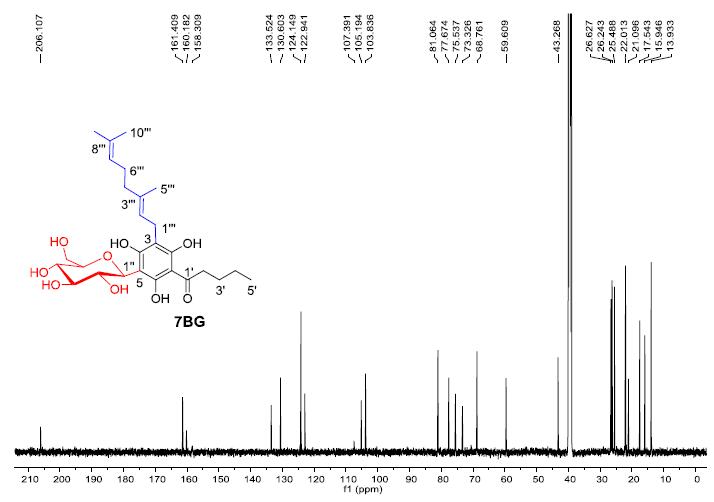| [1] Bililign, T.; Griffith, B.R.; Thorson, J.S. Structure, Activity, Synthesis and Biosynthesis of Aryl-C-glycosides. Nat. Prod. Rep. 2005, 22, 742-760.
[2] Lin, C.I.; McCarty, R.M.; Liu, H.W. The Enzymology of Organic Transformations: A Survey of Name Reactions in Biological Systems. Angew. Chem. Int. Ed. 2017, 56, 3446-3489.
[3] Schmidt, N.G.; Pavkov-Keller, T.; Richter, N.; Wiltschi, B.; Gruber, K.; Kroutil, W. Biocatalytic Friedel-Crafts Acylation and Fries Reaction. Angew. Chem. Int. Ed. 2017, 56, 7615-7619.
[4] Bokor, É.; Kun, S.; Goyard, D.; Tóth, M.; Praly, J.P.; Vidal, S.; Somsák, L. C-Glycopyranosyl Arenes and Hetarenes: Synthetic Methods and Bioactivity Focused on Antidiabetic Potential. Chem. Rev. 2017, 117, 1687-1764.
[5] Barron, D.; Ibrahim, R.K. Isoprenylated Flavonoids-A Survey. Phytochemistry. 1996, 43, 921-982.
[6] Botta, B.; Vitali, A.; Menendez, P.; Misiti, D.; Monache, G.D. Prenylated Flavonoids: Pharmacology and Biotechnology. Curr. Med. Chem. 2005, 12, 713-739.
[7] Li, S.M. Prenylated Indole Derivatives from Fungi: Structure Diversity, Biological Activities, Biosynthesis and Chemoenzymatic Synthesis. Nat. Prod. Rep. 2010, 27, 57-78.
[8] Wu, S.B.; Long, C.; Kennelly, E.J. Structural Diversity and Bioactivities of Natural Benzophenones. Nat. Prod. Rep. 2014, 31, 1158-1174.
[9] Barron, D.; Balland, C.; Possety, F.; Ravanel. P.; Desfougeres, A. Prenyl Flavonoids and Membrane Permeability. Acta Bot. Gallica. 1996, 143, 509-520.
[10] Botta, B.; Monache, G.D.; Menendez, P.; Boffi, A. Novel Prenyltransferase Enzymes as a Tool for Flavonoid Prenylation. Trends Pharmacol. Sci. 2005, 26, 606-608.
[11] Chen, C.N.; Hsiao, C.J.; Lee, S.S.; Guh, J.H.; Chiang, P.C.; Huang, C.C.; Huang, W.J. Chemical Modification and Anticancer Effect of Prenylated Flavanones from Taiwanese propolis. Nat. Prod. Res. 2012, 26, 116-124.
[12] Hultin, P.G. Bioactive C-Glycosides from Bacterial Secondary Metabolism. Curr. Top. Med. Chem. 2005, 5, 1299-1331.
[13] Talhi, O.; Silva, A.M.S. Advances in C-Glycosylflavonoid Research. Curr. Org. Chem. 2012, 16, 859-896.
[14] Šmejkal, K. Cytotoxic Potential of C-Prenylated Flavonoids. Phytochem. Rev. 2014, 13, 245-275.
[15] Tian, L.; Pang, Y.; Dixon, R.A. Biosynthesis and Genetic Engineering of Proanthocyanidins and (Iso) Flavonoids. Phytochem. Rev. 2008, 7, 445-465.
[16] Yang, X.; Jiang, Y.; Yang, J.; He, J.; Sun, J.; Chen, F.; Zhang, M.; Yang, B. Prenylated Flavonoids, Promising Nutraceuticals with Impressive Biological Activities. Trends Food Sci. Tech. 2015, 44, 93-104.
[17] Chen, H.; Walsh, C.T. Coumarin Formation in Novobiocin Biosynthesis: β-Hydroxylation of the Aminoacyl Enzyme Tyrosyl-S-NovH by a Cytochrome P450 NovI. Chem. Biol. 2001, 8, 301-312.
[18] Chen, Y.; Zhao, Y.H.; Jia, X.B.; Hu, M. Intestinal Absorption Mechanisms of Prenylated Flavonoids Present in the Heat-processed Epimedium koreanum Nakai (Yin Yanghuo). Pharm. Res. 2008, 25, 2190-2199.
[19] Veitch, N.C.; Grayer, R.J. Flavonoids and Their Glycosides, including Anthocyanins. Nat. Prod. Rep. 2011, 28, 1626-1695.
[20] Gantt, R.W.; Peltier-Pain, P.; Thorson, J.S. Enzymatic Methods for Glyco (Diversification/Randomization) of Drugs and Small Molecules. Nat. Prod. Rep. 2011, 28, 1811-1853.
[21] Kariu, T.; Nakao, R.; Ikeda, T.; Nakashima, K.; Potempa, J.; Imamura, T. Inhibition of Gingipains and Porphyromonas gingivalis Growth and Biofilm Formation by Prenyl Flavonoids. J. Periodontal. Res. 2017, 52, 89-96.
[22] Lim, E.K. Plant Glycosyltransferases: Their Potential as Novel Biocatalysts. Chem. Eur. J. 2005, 11, 5486-5494.
[23] Bornscheuer, U.T.; Huisman, G.W.; Kazlauskas, R.J.; Lutz, S.; Moore, J.C.; Robins, K. Engineering the Third Wave of Biocatalysis. Nature. 2012, 485, 185-194.
[24] Reetz, M.T. Biocatalysis in Organic Chemistry and Biotechnology: Past, Present, and Future. J. Am. Chem. Soc. 2013, 135, 12480−12496.
[25] Turner, N.J.; O′Reilly, E. Biocatalytic Retrosynthesis. Nat. Chem. Biol. 2013, 9, 285-288.
[26] Hoffmeister, D.; Dräger, G.; Ichinose, K.; Rohr, J.; Bechthold, A. The C-Glycosyltransferase UrdGT2 is Unselective toward D- and L-Configured Nucleotide-bound Rhodinoses. J. Am. Chem. Soc. 2003, 125, 4678-4679.
[27] Brazier-Hicks, M.; Evans, K.M.; Gershater, M.C.; Puschmann, H.; Steel, P.G.; Edwards, R. The C-Glycosylation of Flavonoids in Cereals. J. Biol. Chem. 2009, 284, 17926-17934.
[28] Hao, B.; Caulfield, J.C.; Hamilton, M.L.; Pickett, J.A.; Midega, C.A.O. Khan, Z.R.; Wang, J.; Hooper, A.M. Biosynthesis of Natural and Novel C-Glycosylflavones utilising Recombinant Oryza sativa C-Glycosyltransferase (OsCGT) and Desmodium incanum Root Proteins. Phytochemistry. 2016, 125, 73-87.
[29] Yang, Y.; Yu, B. Recent Advances in the Chemical Synthesis of C-Glycosides. Chem. Rev. 2017, 117, 12281-12356.
[30] Yazaki, K.; Sasaki, K.; Tsurumaru, Y. Monoterpene and Sesquiterpene Synthases and the Origin of Terpene Skeletal Diversity in Plants. Phytochemistry. 2009, 70, 15-16.
[31] Fan, A.; Winkelblech, J.; Li, S.M. Impacts and Perspectives of Prenyltransferases of the DMATS Superfamily for use in Biotechnology. Appl. Microbiol. Biotechnol. 2015, 99, 7399-7415.
[33] Zou, Y.; Zhan, Zh.; Li, D.; Tang, M.; Cacho, R.A.; Watanabe, K.; Tang, Y. Tandem Prenyltransferases Catalyze Isoprenoid Elongation and Complexity Generation in Biosynthesis of Quinolone Alkaloids. J. Am. Chem. Soc. 2015, 137, 4980−4983.
[34] Zhou, K.; Wunsch, C.; Dai, J.; Li, S.M. gem-Diprenylation of Acylphloroglucinols by a Fungal Prenyltransferase of the Dimethylallyltryptophan Synthase Superfamily. Org. Lett. 2017, 19, 388−391.
[35] Chen, D.; Chen, R.; Wang, R.; Li, J.; Xie, K.; Bian, C.; Sun, L.; Zhang, X.; Liu, J.; Yang, L.; Ye, F.; Yu, X.; Dai, J. Probing the Catalytic Promiscuity of a Regio- and Stereospecific C-Glycosyltransferase from Mangifera indica. Angew. Chem. Int. Ed. 2015, 54, 12678-12682.
[36] Chen, R.; Gao, B.; Liu, X.; Ruan, F.; Zhang, Y.; Lou, J.; Feng, K.; Wunsch, C.; Li, S.M.; Dai, J.; Sun, F. Molecular Insights into the Enzyme Promiscuity of an Aromatic Prenyltransferase. Nat. Chem. Biol. 2017, 13, 226-234.
[37] Carroll, A.R.; Fechner, G.A.; Smith, J.; Guymer, G.P.; Quinn, R.J. Prenylated Dihydrochalcones from Boronia bipinnata that Inhibit the Malarial Parasite Enzyme Target Hemoglobinase II. J. Nat. Prod. 2008, 71, 1479-1480.
[38] Zhao, X.L.; Li, H.Z.; Zhang, X.S.; Wang, W.J.; Da, S.J.; Li, Y.A. Concise Synthetic Approach to Dihydrochalcone: First Total Syntheses of Bipinnatone A and B. Chin. Chem. Lett. 2011, 22, 1135-1138.
[39] Tadigoppula, N.; Korthikunta, V.; Gupta, S.; Kancharla, P.; Khaliq, T.; Soni, A.; Srivastava, R.K.; Srivastava, K.; Puri, S.K.; Raju, K.S.R.; Wahajuddin; Sijwali, P.S.; Kumar, V.; Mohammad, I.S. Synthesis and Insight into the Structure-activity Relationships of Chalcones as Antimalarial Agents. J. Med. Chem. 2013, 56, 31−45.
[40] Basabe, P.; de Román, M.; Marcos, I.S.; Diez, D.; Blanco, A.; Bodero, O.; Mollinedo, F.; Sierra, B.G.; Urones, J.G. Prenylflavonoids and Prenyl/Alkyl-phloroacetophenones: Synthesis and Antitumour Biological Evaluation. Eur. J. Med. Chem. 2010, 45, 4258−4269.
[41] Ricca, E.; Brucher, B.; Schrittwieser, J.H. Multi-enzymatic Cascade Reactions: Overview and Perspectives. Adv. Synth. Catal. 2011, 353, 2239-2262.
[42] Köhler, V.; Wilson, Y.M.; Dürrenberger, M.; Ghislieri, D.; Churakova, E.; Quinto, T.; Knörr, L.; Häussinger, D.; Hollmann, F.; Turner, N.J.; Ward, T.R. Synthetic Cascades are Enabled by Combining Biocatalysts with Artificial Metalloenzymes. Nat. Chem. 2013, 5, 93-99.
[43] Schmidt, S.; Castiglione, K.; Kourist, R. Overcoming the Incompatibility Challenge in Chemoenzymatic and Multi-catalytic Cascade Reactions. Chem. Eur. J. 2018, 24, 1755-1768.
[44] Ito, T.; Fujimoto, S.; Suito, F.; Shimosaka, M.; Taguchi, G. C-Glycosyltransferases Catalyzing the Formation of Di-C-glucosyl Flavonoids in Citrus Plants. Plant J. 2017, 91, 187-198.
[45] Dirks-Hofmeister, M.E.; Verhaeghe, T.; De Winter, K.; Desmet, T. Creating Space for Large Acceptors: Rational Biocatalyst Design for Resveratrol Glycosylation in an Aqueous System. Angew. Chem. Int. Ed. 2015, 54, 9289-9292. |
.jpg)
.jpg)
.jpg)
.jpg)
.jpg)
.jpg)
.jpg)
.jpg)
.jpg)
.jpg)
.jpg)
.jpg)
.jpg)
.jpg)
.jpg)
.jpg)
